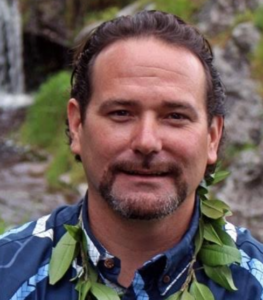Decades ago, my uncle Keola Beamer wrote my favorite lines to his song 鈥淭he Beauty of Mauna Kea.鈥�
The song provided comfort when I was away in college and deeply missing home. When I reached the phrase, 鈥渘ow to any land you roam, she will be with you, if you love her like I do,鈥� my gut would tremor, my eyes would tear up, and I would feel the connection with my home and our precious Mauna Kea.
This love my uncle sang of was active, visceral, and endless. It is an articulation of a deep and profound realization of thanks for the beauty and majesty of a mountain and the life she has provided for hundreds of generations.
My grandmother Nona Beamer discusses in her album “The Golden Lehua Tree,” how Mauna Kea was like 鈥渁 Kahu,鈥� a family guardian, and a 鈥渟trong reminder to us to stand firm in our beliefs,鈥� — 鈥渓ike a kupuna a Hawaiian elder who was a part of our family.鈥�

I recall these passages to convey the deep feelings of aloha and kinship many kanaka have with Mauna Kea. It is my honest attempt to express the intergenerational aloha and relationships we have and continue to hold with Mauna Kea.
From this perspective, it is difficult for me to see Mauna Kea as anything less than 鈥渒apu鈥� or what we call in English 鈥� sacred. She is the embodiment and the genesis for the love and stories of my family, she has formed the very soil and coalesced the fresh waters that feed us. She is the place we laid my kupuna to rest. She is what the Bible refers to as 鈥渉oly ground.鈥� She is majestic, she is precious. It is difficult to express in English because the richer Hawaiian term 鈥渒apu鈥� does not have a full translation in the English language.
Our ancestors intimately understood and deified natural systems because they gave us life. In our time of climate crisis, our world would benefit from reckoning with our relationships with ecosystems. Mauna Kea deserves to be cared for with the reverence a person of Jewish faith has for Mount Sinai, or a conservationist would have for the Swiss Alps, or simply put like my grandmother had for Mauna Kea.
After 50 years of utter mismanagement by the University of Hawaii, the same system that many of us love and cherish 鈥� we demand better leadership. The singular focus to expand one industry and perspective on Mauna Kea has hurt us all. At present the density and sprawl of the existing 13 astronomy facilities on Mauna Kea (some of which are unused) is unacceptable.
We need to rethink the composition, structure and requirements of the entire Board of Regents.
Unkept promises to begin decommission before building the TMT are salt in the wounds. Consider that even former Hawaii County Mayor Herbert Matayoshi (1974-1984) wanted a cap of six telescopes. There are 13 telescope facilities now, with TMT proposed to be 18 stories tall and positioned on one of the few remaining un-developed plateaus. It cannot be the 14th.
UH leadership has failed. Leadership has failed our Kia驶i by being complicit in arresting kupuna and forcing people to sacrifice so much to conduct non-violent direct action for justice. They have failed TMT by applying for a permit without the 鈥渇ree, prior and informed consent鈥� of Hawaiians. They have failed Mauna Kea because for 50 years they could have truly shared the mountain.
What if they had established programs to reforest and steward Mauna Kea? What if they learned from generations of cultural practitioners? What if they empowered Hawaiian leadership of Mauna Kea? Or what if they had balanced seats for Hawaiian educators on the board to complement those who represent other interests?
At this point, we need to rethink the composition, structure and requirements of the entire Board of Regents. We need future university leadership to never bring our islands into such a quagmire. We need balanced leadership.
Given the last 50 days 鈥� the Pu驶uhonua, the outpouring of courage and aloha, the police and National Guard 鈥� I am certain our Hawaii will never be the same. It鈥檚 impossible to go back to a time where there was no development on Mauna Kea, and equally impossible to persist in marginalizing community voices through dismissal, intimidation, or coercion.
We have reached a tipping point, a rare moment that comes perhaps once every few generations. We see clearly our past for its glory and failures while we stand shoulder to shoulder with fearlessness and a strong political will to bring about systemic change.
It is a time for leadership and follow-ship with courage and humility. It is a time of inclusion and ally-ship. It is a time for Kapu Aloha and Aloha Aina. Our time is now.
 GET IN-DEPTH
REPORTING ON HAWAII鈥橲 BIGGEST ISSUES
GET IN-DEPTH
REPORTING ON HAWAII鈥橲 BIGGEST ISSUES
Community Voices aims to encourage broad discussion on many topics of community interest. It鈥檚 kind of a cross between Letters to the Editor and op-eds. This is your space to talk about important issues or interesting people who are making a difference in our world. Column lengths should be no more than 800 words and we need a current photo of the author and a bio. We welcome video commentary and other multimedia formats. Send to news@civilbeat.org.聽The opinions and information expressed in Community Voices are solely those of the authors and not Civil Beat.
We need your help.
Unfortunately, being named a聽finalist for a聽Pulitzer prize聽doesn’t make us immune to financial pressures. The fact is,聽our revenue hasn鈥檛 kept pace with our need to grow,听.
Civil Beat is a nonprofit, reader-supported newsroom based in 贬补飞补颈驶颈. We鈥檙e looking to build a more resilient, diverse and deeply impactful media landscape, and聽we hope you鈥檒l help by .


